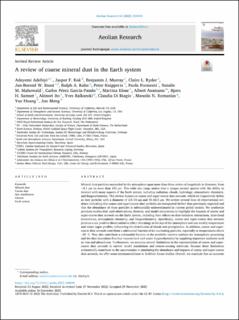| dc.description.abstract | Mineral dust particles suspended in the atmosphere span more than three orders of magnitude in diameter, from <0.1 μm to more than 100 μm. This wide size range makes dust a unique aerosol species with the ability to interact with many aspects of the Earth system, including radiation, clouds, hydrology, atmospheric chemistry, and biogeochemistry. This review focuses on coarse and super-coarse dust aerosols, which we respectively define as dust particles with a diameter of 2.5–10 μm and 10–62.5 μm. We review several lines of observational evidence indicating that coarse and super-coarse dust particles are transported farther than previously expected and that the abundance of these particles is substantially underestimated in current global models. We synthesize previous studies that used observations, theories, and model simulations to highlight the impacts of coarse and super-coarse dust aerosols on the Earth system, including their effects on dust-radiation interactions, dust-cloud interactions, atmospheric chemistry, and biogeochemistry. Specifically, coarse and super-coarse dust aerosols produce a net positive direct radiative effect (warming) at the top of the atmosphere and can modify temperature and water vapor profiles, influencing the distribution of clouds and precipitation. In addition, coarse and supercoarse dust aerosols contribute a substantial fraction of ice-nucleating particles, especially at temperatures above –23 ◦C. They also contribute a substantial fraction to the available reactive surfaces for atmospheric processing and the dust deposition flux that impacts land and ocean biogeochemistry by supplying important nutrients such as iron and phosphorus. Furthermore, we examine several limitations in the representation of coarse and supercoarse dust aerosols in current model simulations and remote-sensing retrievals. Because these limitations substantially contribute to the uncertainties in simulating the abundance and impacts of coarse and super-coarse dust aerosols, we offer some recommendations to facilitate future studies. Overall, we conclude that an accurate | en_US |

